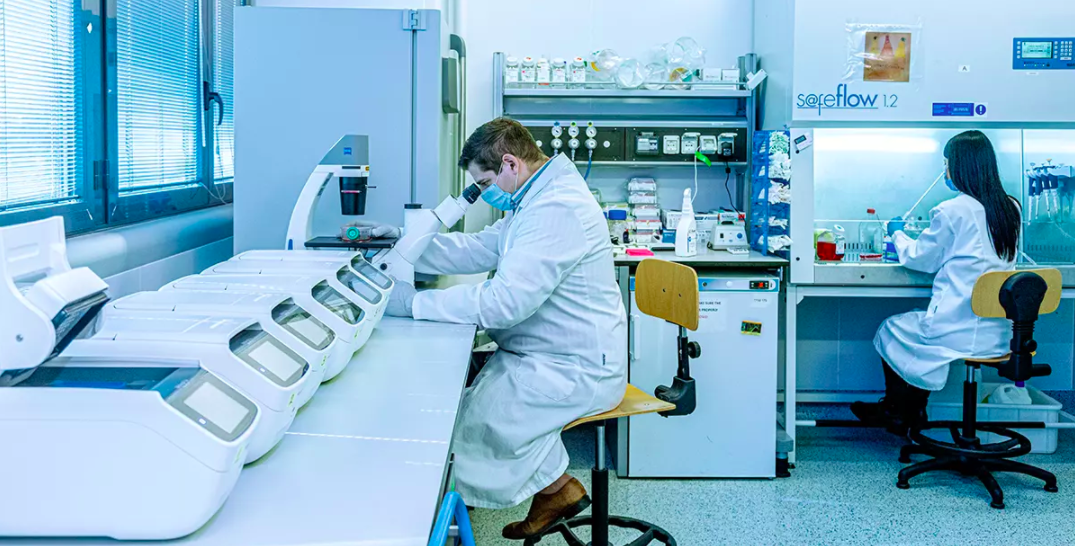A Day in the Race Against COVID-19
HP microfluidics technology is helping speed up the search for effective treatments to combat the novel coronavirus.

By Sara Harrison
Just outside the medieval walled city of Siena, the Tuscan hill town known for its famed Palio horse race, a different kind of race is happening at Toscana Life Sciences Foundation. This one is on a microscopic scale, as senior scientist Claudia Sala and her team research a treatment for COVID-19, which is projected to cause nearly 2.7 million global deaths by year’s end.
Sala studies monoclonal antibodies, or mAbs, tiny proteins the human body produces to fight off infections from bacteria and viruses. By finding and cloning the right mAbs, she and other scientists are hoping to create a powerful therapy that could help treat COVID-19 and even protect frontline workers. With help from HP inkjet printing technology and other partners, researchers could find those antibodies in record time.
“In normal conditions, the production of monoclonals would take at least one year,” says Sala. She’s hoping to get these out in just six short months and to start clinical trials this December. Here’s a look at Claudia Sala’s typical day inside the lab.
8:00 A.M. / The search kicks off
Sala lives just outside Siena, once a center of political and cultural power that rivaled Florence in the 13th century. Its population was devastated by the Black Death and the city never recovered its former glory, something the scientist reflects on every time she glimpses the town’s ornate but never-finished Duomo. Her short commute takes her to Siena’s suburbs, where Toscana Life Sciences is home to nine research projects — including the Monoclonal Antibody Discovery (MAD) Lab, led by Sala — all focused on making biomedical advances.
Sala first tackles a mountain of emails each morning. Before COVID-19, she and her team were searching for mAbs that could fight off antibiotic-resistant bacteria. But as the pandemic swept through Northern Italy in late February, Sala and the lab’s principal investigator, Rino Rappuoli, decided to temporarily abandon their bacteria research and devote the lab’s energies and resources to finding a treatment for COVID-19.
The MAD Lab is among a handful of research institutions benefiting from HP’s donation of D300e BioPrinters, supply cassettes, and training to help accelerate drug and vaccine research to combat COVID-19. The BioPrinter emerged from HP’s expertise with microfluidics, which is a broad research area that’s enabled by precision placement of microscopic amounts of fluid.
Monoclonal antibodies work because they bind to the surface of a bacterium or virus and keep it from attaching to cells and replicating. While mAbs can be harnessed to treat a range of pathogens, each treatment relies on an antibody that is uniquely suited to bind to each virus or bacterium. “You need a very specific key to open a specific door,” says Sala. Testing endless variations of those “keys” to find the right one that will fit into COVID-19 is a slow process—unless you have a printer to set up and run those tests for you.
9:00 a.m. / The team checks in
The group has doubled to 14 members since February as Sala added scientists with specialties in cell and virus biology. Sala huddles with immunologists Anna Kabanova and Emanuele Andreano and the biologists and data scientists to review the previous day’s results and discuss next steps.
Monoclonal antibodies are naturally produced by the human body, so Sala doesn’t have to go through the long approval process necessary for chemically made drugs. She hopes that will help the lab get the mAbs into clinical trials sooner and get the treatment to people faster. Eventually, the dream is to create an oral spray, but for now, she’s focused on delivering the mAbs through an intramuscular or subcutaneous injection that acts as a prophylactic to boost a patient’s immune system. The medication could be given to healthcare workers or essential workers before they head into hot spots.
While mAbs do offer protection, they usually only last two or three months, because unlike a vaccine, monoclonals don’t train the human immune system to respond on its own. Once the monoclonals leave the body, the protection is gone.

